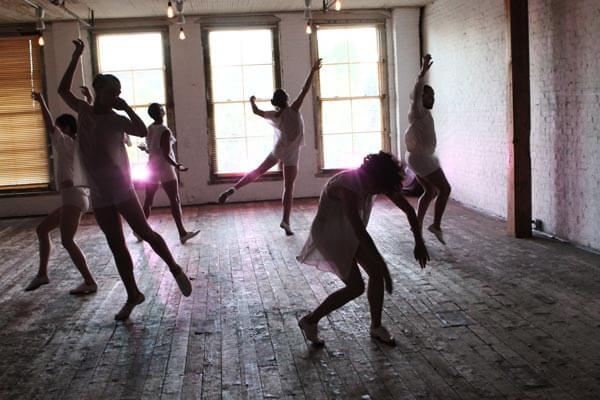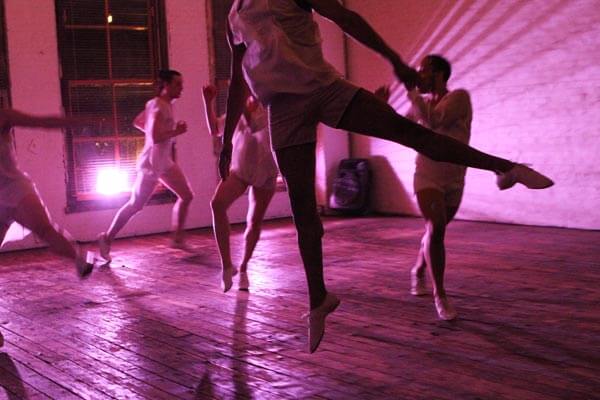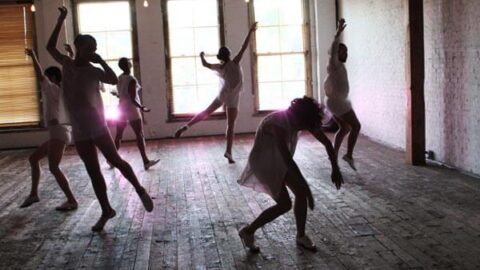 Over a year ago I heard Arundhati Roy barraged with a series of idiotic questions from a couple college professors after a talk she gave on her book, Walking with the Comrades, about the Naxalite communist guerilla insurgency in India. The idiocy resulted from the wide gap between well-intentioned US intellectuals and the real life experiences of oppression and resistance among the impoverished Indian peasants and Adivasis depicted in Roy’s book. Perhaps the most inane question asked to her was “how do you find the beauty in the most terrible circumstances?” Roy’s excellent response was something to the effect of “Because it’s there!…in the people struggling for their very existence and seeking to create a better world” (her exact words were more poetic.) Such beauty in the midst of the worst of atrocities was captured by recent performances of Coming Together / Attica by Frederic Rzewski with original choreography by Rebecca Lazier. On June 13-15, 2013, at the Invisible Dog Art Center in Brooklyn, Newspeak ensemble, conducted by David T. Little, and Lazier’s dancers projected a fleeting moment of human dignity for the oppressed in American history.
Over a year ago I heard Arundhati Roy barraged with a series of idiotic questions from a couple college professors after a talk she gave on her book, Walking with the Comrades, about the Naxalite communist guerilla insurgency in India. The idiocy resulted from the wide gap between well-intentioned US intellectuals and the real life experiences of oppression and resistance among the impoverished Indian peasants and Adivasis depicted in Roy’s book. Perhaps the most inane question asked to her was “how do you find the beauty in the most terrible circumstances?” Roy’s excellent response was something to the effect of “Because it’s there!…in the people struggling for their very existence and seeking to create a better world” (her exact words were more poetic.) Such beauty in the midst of the worst of atrocities was captured by recent performances of Coming Together / Attica by Frederic Rzewski with original choreography by Rebecca Lazier. On June 13-15, 2013, at the Invisible Dog Art Center in Brooklyn, Newspeak ensemble, conducted by David T. Little, and Lazier’s dancers projected a fleeting moment of human dignity for the oppressed in American history.

Rzewski composed Coming Together and Attica in the early 1970s, shortly after the brutal massacre by New York state authorities of the 1971 Attica prison rebellion. The music itself and the text recited over it — a letter from one of the rebellion’s deceased leaders, political prisoner Sam Melville — has a decidedly optimistic tone. Rzewski clearly saw the tremendous beauty and power of prisoners standing up for their dignity that the authorities wanted so badly to stamp out. Lazier’s choreography ultimately, at least in my experience, captured this side of the conflict.
Part of why this sense of dignity and struggle came alive was how the performance drew the audience into its environment. Bright florescent lights were quite a discomfort at the beginning — a nice detail that reminded me of one facet of jail that gives you a migraine within a few hours (the other being the overpowering smell of chemical cleaners used to mop the floor—perhaps this stench can be added for future performances). Placing the musical ensemble, Newspeak, behind the performance square and, at times, using overpowering amplification, added to the discomfort. What topped it off was the often extremely close proximity to the audience of the dancers themselves as well as their use of the whole floor. It was simply impossible to be physically disconnected from this performance, and this breakdown of the audience-performer barrier was a welcome change of format.
The sense of physical power of guard over prisoner in contorted physical gestures was another source of discomfort, but also presented in a way that made it a normalcy — which of course it is for well over two million people incarcerated in the US today. But as the physical conflict increasingly became two-sided, something came alive in the performance. The ostinatos from the ensemble settled into a relentless drive, the drumset provided powerful crashes of energy, held notes on the electric guitar were anything but stasis, and narrator Mellissa Hughes’ celebration of dignity reached towards triumph. All this was led by the grace of dancers locked in struggle and conveying an increasing sense of empowerment in physical gestures. Lazzier’s choreography was by no means a simple blow-by-blow depiction of rebellion, but rather a totality that exemplified possibilities.

The success of this work was also the result of reaching inside the tension between constraints and freedom. Besides the quite literal thematic sense of this tension, Rzewski’s composition gave Newspeak pre-composed structures with which to interpret in a myriad of ways, and the ensemble’s synergy with the choreography guided expressive interpretation of the composition. The high and low points, the emphasis on different instruments, and tone shading all came in the right places without feeling pre-planned. The dancers’ movements all had a sense of being “in the moment,” adapting to the exigencies of particular performance and with the emotions of the work being internalized by each dancer rather coming off as an external mask for performance purposes. Achieving this holistic cohesion and improvisatory feeling is quite a rare feat.
It is rather difficult to provide a truly objective review of this event because it provoked such an emotional response. I’m sure many others walked away with a different interpretation than mine, but hopefully the contemporary import of this work in a country with more African American men under correctional control than were enslaved in 1850 was not lost on anyone.
[Ed. For more background on the Coming Together / Attica project, see David Pearson’s recent interview with Rebecca Lazier.]
























